Why are there so many abbeys in Normandy?
A bit of history about Norman Abbeys…
Precursors of the monastic movement: hermits and missionaries
The first monasteries in Normandy often originated from a modest hermitage. Hagiographic accounts of the 6th century mention the foundations destined for the evangelisation of the Saxon peoples of the coastal area.
Le The 7th century, golden age of foundations in Neustria
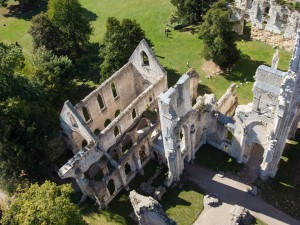
Jumièges abbey ©Michel-Dehaye-avudoiseau.com
The 7th century was marked by a true flowering of monastic foundations in Neustria. Some fall in the tradition of royal foundations, begun in the previous century by the Merovingian dynasty. These include the large monastery of Jumièges, which was built in 654. But most were founded by the aristocracy, in the heart of their family properties.
The splendour of pre-Norman abbeys (7-9th centuries)
In Normandy, only one monastic building of the High Middle Ages is still standing: the nave of Saint-Pierre abbey church in Jumièges, dating back to the start of the 9th century. The life of Saint Philibert and Fontenelle’s chronicle have also left us two precious descriptions of the monastic buildings of Jumièges and Saint-Wandrille.
The shock of the Scandinavian raids (9th century)
The rich abbeys of Neustria were the target of Nordic attacks starting from 841. Starting in 860, sites in the lower Seine Valley were almost all evacuated. Bringing with them the relics and what they could save of their treasures and archives, the monks left for refuges farther and farther away, and they were regularly chased away by fresh alerts.
The monastic renaissance of the 10th century
After the treaty of Saint-Clair-sur-Epte (911), Rollon’s baptism should have opened the way for the monks’ return to Normandy. But the restoration of the monasteries involved a host of problems. The reconstruction of monasticism in Normandy was thus a very long process. Begun in 918 with the reconstruction of the episcopal abbey of Saint-Ouen in Rouen, it continued throughout the 11th century and sometimes, in certain areas of the duchy, even up to the start of the following century.
William of Volpiano and monastic reform
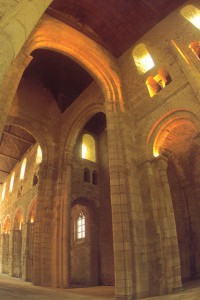
Bernay abbey
In 1001, Duke Richard II called on William of Volpiano to restore monasticism in Normandy. William agreed to come and reform the Fécamp community, located close to the duke’s palace. He turned Fécamp into a model Benedictine abbey.
William of Volpiano’s influence spread throughout Normandy. The monks of Fécamp, his disciples, founded or restored numerous abbeys in Normandy: the new abbey of Bernay (around 1015), Saint-Taurin of Évreux, Montivilliers (1035) and Mont Saint-Michel…
The great ducal monasteries
All the dukes of the 11th century founded monasteries, which were places of prestige allowing them to celebrate their own glory, as well as God’s. They followed the example of William Longsword (the restorer of Jumièges) and the succession of dukes named Richard (the restorers of Fécamp). Richard the Magnificent also restored two old monasteries destroyed by the Vikings: the men’s abbey in Cerisy [-la-Forêt], in 1035, and the women’s abbey of Montivilliers, in 1035.
William the Bastard and his wife Duchess Matilda built two monasteries on either side of the new city of Caen: the Abbaye-aux-Dames (Women’s Abbey) and the Abbaye-aux-Hommes (Men’s Abbey).
Aristocratic foundations
The great Norman aristocrats did not wait long to imitate the dukes’ example, by founding their own monasteries.
Bec Abbey is the exception, because it was founded by a simple knight, Herluin, who became the abbot. Despite its humble origins, it did not lack intellectual influence.
Foundations multiplied around the middle of the 11th century (1050-1060). Guillaume Giroie restored Saint-Évroult Abbey. Notre-Dame-du-Pré Abbey was established by Lesceline, the widow of the Count d’Eu, in Lisieux. We can also mention Lessay Abbey, founded by Turstin Haldup, in 1056
Norman Romanesque architecture
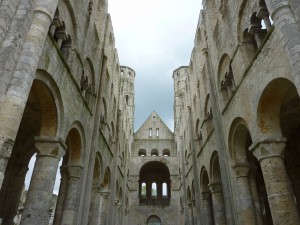
Jumièges abbey
During the 11th and 12th centuries, there was a significant flowering of churches, cathedrals and abbey churches. The oldest is Bernay abbey church, built in the mid-11th century. It was followed by Notre-Dame of Jumièges (1067), Trinité and Saint-Étienne of Caen (1077), Cerisy-la-Forêt, Lessay (late 11th century) and Saint-Georges of Boscherville (12th century).
All these great churches have shared characteristics: what we call “the Norman Romanesque style.” These edifices most often follow the Benedictine plan, without an ambulatory in the choir (except in Jumièges). However, the nave is flanked by side aisles. The transept crossing is surmounted by an impressive lantern tower.
Generally, sculpted décor is limited, but this may be because these are monastic churches, and thus intentionally austere. This is what the remains of the Romanesque décor of Bayeux Cathedral suggest. The great Norman edifices often inspired the cathedrals or abbey churches built in England after 1066
From Romanesque to Norman Gothic
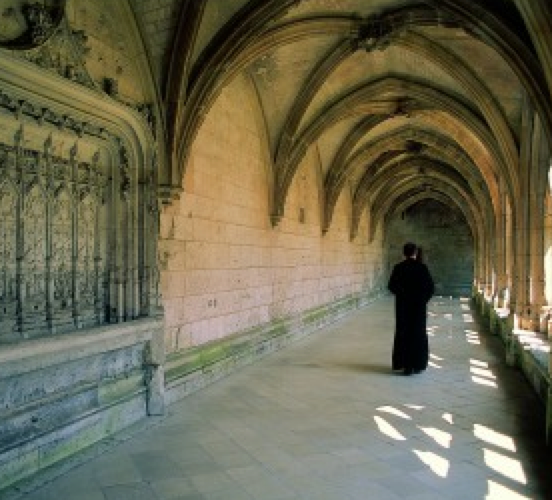
Saint-Wandrille abbey 2©SMT-E.Benard
The Gothic style, originating in the Île de France region, came to Normandy from the mid-12th century on. In the late 12th century, the characteristic components of the “Norman Gothic style” began to appear: support for the “thick wall,” tribunes or long galleries on all levels, as during the Romanesque era, décor favouring trefoils and quatrefoils. The first great construction applying these principles is the choir of Saint-Étienne Abbey in Caen. These are found again in “La Merveille” of Mont Saint-Michel, and in the Cathedrals of Rouen, Coutances, Bayeux and Sées. The great Gothic abbey churches were destroyed after the Revolution: Saint-Wandrille, Jumièges (choir) and Saint-Évroult. However, others such as Saint-Sever, Lonlay-l’Abbaye and Fontaine-Guérard remain to this day.
Most of these constructions date back to the first half of the 13th century. Then, the Normans followed the French style originating from Paris, as it evolved. We thus find constructions of the rayonnant style (1250-1350) and, after the end of the Hundred Years War (1337-1450), numerous edifices of the flamboyant style. The masterpieces of this era in Normandy are the Saint-Ouen abbey church of Rouen, built in 1318, in the rayonnant style, and completed in the flamboyant style, as well as the choir of Mont Saint-Michel Abbey.
The Saint Maur congregation
In 1536, François I introduced the commendatory system. He created the role of commendatory abbot, to which he appointed one of his friends, whether a lay person or a priest, whom he wanted to reward. The abbot then received the revenue from the abbey, where he was only rarely in residence (if at all), and left only a small portion to the resident monastic community for its operation and the maintenance of its buildings.
This led to the decline of many abbeys, as much on the material level as on the spiritual.
At the beginning of the 17th century, the Saint Maur congregation, from eastern France, supported by Louis XIII and Cardinal de Richelieu, helped to reform the abbeys. This was a centralised order, based at Saint Germain des Prés Abbey, which focused on intellectual work, discipline and the spiritual reform of monastic communities. It only intervened at the abbots’ request.
Its success was great. The knowledge that Louis XIII and Richelieu encouraged its actions certainly contributed to this. In Normandy, many abbeys called on this congregation over the years: Saint-Ouen, Jumièges, Bec Hellouin, Saint-Georges de Boscherville, the Abbaye aux Hommes (Men’s Abbey), etc …
The Maurist monks were also great builders. They grouped together medieval outbuildings (refectories, kitchens, dormitories, warming rooms), previously scattered and inconvenient, into a vast central building, often of remarkable architectural quality. They preserved abbey churches and sometimes chapter houses.
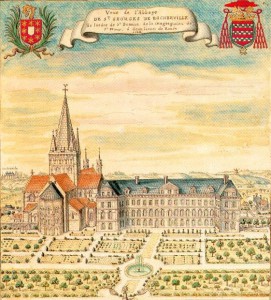
Saint-Georges de Boscherville abbey, from Gaignière
Texts by Jacques Le Maho and François Neveux, from the book “La Normandie monastique” [“Monastic Normandy”], Point de Vues publishing.
Text on the Congregation of Saint-Maur by D.Cyrot, Saint-Georges de Boscherville Abbey.



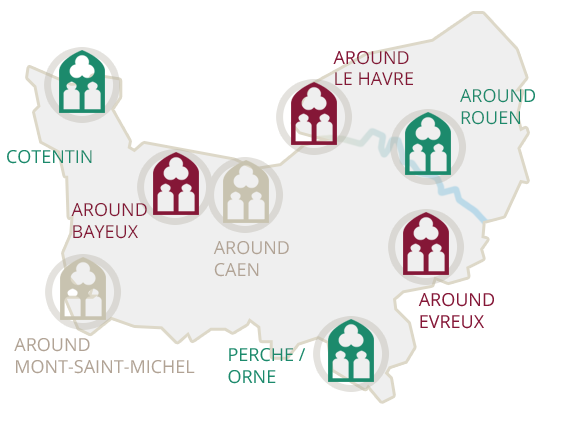

 Krea3
Krea3